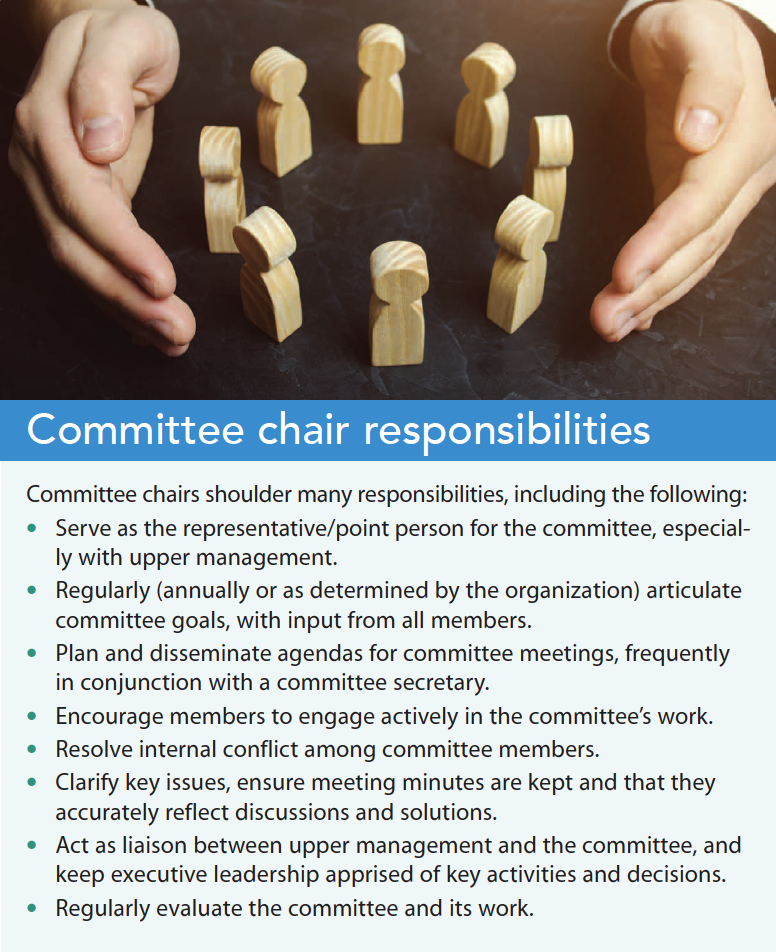Begin your leadership journey.
- Serving as committee chair provides leadership experience.
- Developing leadership skills enhances personal career growth and benefits the nursing profession.
- Nursing requires leaders to help transform healthcare.
You find yourself wanting to dip your toe into the waters of leadership, but you’re unsure how to start. Various types of leadership styles exist, but what’s yours? You’re curious and feel that you have something to contribute to your organization. You have a good understanding of the job, of the organization, and you may even have some ideas for improvement. You want to make an impact. Volunteering to serve on a committee provides a good starting point. When you feel comfortable with the committee’s work and the other members, you can step up to take on the committee chair role.
Breathing life back into a medical ethics committee
Committee work: A nurse’s secret to survival during “go live”
Sustaining a shared governance organization
Be a driving force
Not only do nurses advance their profession, they also help drive positive health outcomes for patients, families, and communities. A committee chair acts as a direct liaison between practice and management, especially in acute care settings. At this foundational level they can significantly influence patient care and practice.
Repurpose bedside skills
Nurses’ bedside skills—coordination, supportiveness, adaptability, flexibility, and communication—frequently are the same as those found in successful leaders. The prime difference is that leaders have fine-tuned their skills and instincts from experience and so have developed more maturity and sensitivity to nuance. Nurse leaders possess a sense of how to navigate people and situations, which can help influence outcomes at the bedside.
Leaders know how and when to inform others of immediate and imminent changes, they regularly use therapeutic communication skills, and they know how to get things done and meet goals. Understanding and enacting procedures and guidelines at this level aids the development of competence in policy construction and implementation. Ideas and innovations act as the nursery for policy development that can be used to grow the profession and reimagine the healthcare system.
Make yourself an asset
Serving as a committee chair signifies to upper management that you’re open to training, so they’ll invest in you, which makes you valuable to the organization. It also tells your peers that you’re willing to work with your organization, which allows you to be a role model and help set the tone for the work environment. Establishing this tone, working effectively with others, and meeting objectives promote a positive work environment for everyone. Recent research indicates that a safe environment can contribute to safe, quality patient outcomes.
Serve as an ambassador
As ambassadors for top leadership, committee chairs share the organization’s vision and mission with the committee and unit. Top executive responsibilities include decision making, managing disturbances, and serving as spokespersons. They’re also called upon to serve as enablers, chief engagement officers, and effective communicators. To that end, committee chair duties support that work. When nurses exert leadership (function in the role of a committee chair in any setting), they inspire others to work toward established goals, which can include providing high-quality patient care, maintaining a safe working environment, developing policies and procedures, influencing practice, and increasing nursing’s power.
Be prepared to serve
Successful committee chairs possess several skillsets and character traits. They also understand what not to do. (See Committee chair responsibilities.)


Skillsets and character traits
The skillsets a committee chair needs include effective communication, a willingness to collaborate, quality time management, organizational proficiency, problem-solving acumen, a commitment to lifelong learning, and adaptability to evolving situations, membership, and agendas. Other important skills include risk management, negotiation, budget alignment, and technical skills. Committee chairs must think methodically, systematically, and critically, and they must possess patience. Strong committee chairs can read body language and adjust accordingly, and they offer insight and direction to members. In addition, a good sense of humor can help committee chairs endure the challenge of this work.
Successful committee chairs also possess several character traits, including honesty, trustworthiness, impartiality, and empathy. They embrace the characteristics frequently referenced in the American Nurses Association Code of Ethics for Nurses with Interpretive Statements—they strive to work and problem-solve ethically.
To ensure committees reach their frequently expansive goals, chairs must embrace creativity and innovation without overreaching. Accomplishing this requires using member expertise. Committees need the gifts, skillsets, and experience of many to solve problems. It takes drive, commitment, and passion along with the previously described skills and attributes to draw out the best in members and advance the committee.
What not to do
Quality committee chairs know what not to do during meetings and deliberations. They know how and when to move away from discussion and debate so the group can move to decision-making. They also know not to let one or two members dominate discussions or meetings, not to dismiss member comments, and not to allow members to denigrate or mock each other. Good committee chairs never break confidences, encourage side conversations, or allow meetings to become unproductive.
High-performing committee chairs strive to cultivate an inclusive committee, embracing all perspectives and actively listen to the membership. They also establish a succession plan and actively mentor potential new chairs.
Take the first step
Armed with information about what it takes to serve as a committee chair, you can sample what leadership feels like. Through your work as a chair, your organization will have an opportunity to determine if you’re a good fit for a formal leadership position. However, if you’re not, remember that the skills you’ve developed will help you find another worthy position. Future employers will appreciate the experience you bring.
Dipping your toe into leadership could be the beginning of immersing yourself in the leadership pool. Nursing needs leaders to transform our healthcare system. Your contributions as a committee chair provide a good starting place on the path to transformative leadership for the entire profession.
Julia A. Greenawalt is a professor at Indiana University of Pennsylvania in Indiana, Pennsylvania.
American Nurse Journal. 2023; 18(1). Doi: 10.51256/ANJ012320
Key words: committee chair, leadership, skillset and role.
References
Bruce M. How to be a great committee chair. ChiefExecutive. chiefexecutive.net/how-to-be-a-great-committee-chair
Catalano JT. Nursing Now: Today’s Issues, Tomorrow’s Trends. 8th edition. Philadelphia, PA: F.A. Davis; 2019.
Fowler MDM. Guide to the Code of Ethics for Nurses with Interpretative Statements: Development, Interpretation, and Application. 2nd ed. Silver Spring, MD: American Nurses Association; 2015.
IMD. The 5 most common leadership styles & how to use them. November 2022. www.imd.org/reflections/leadership-styles
Smythe J. The CEO: Chief Engagement Officer: Turning Hierarchy Upside Down to Drive Performance. Aldershot, UK: Gower Publishing; 2017.


















